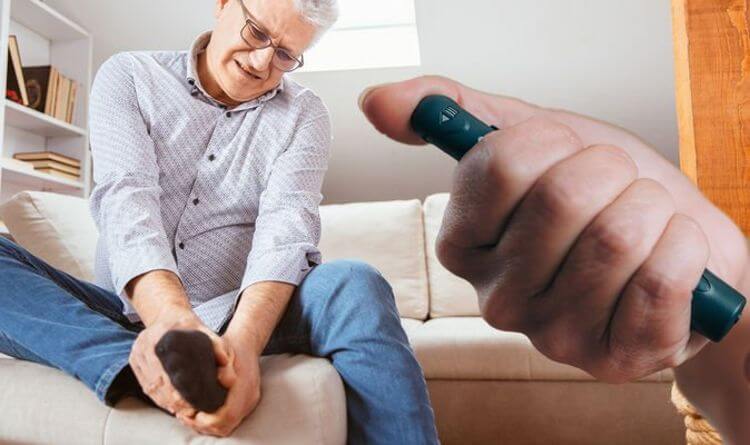Ever wondered why diabetics die after amputations? It’s a stark reality, yet one shrouded in misconceptions and fear. But why? Visualize entering a realm where someone has diabetes – it’s an intricate jigsaw of maintaining blood sugar, tackling cardiovascular risk elements such as high BP, and defending against likely foot ailments that can cause sores.
Then comes the word nobody wants to hear: Amputation. Suddenly, you’re not just fighting against daily symptoms but also grappling with life-altering decisions and outcomes. Now add another layer – higher mortality risks post-amputation due to complications such as kidney disease or myocardial infarction. It’s important to know that the journey from diagnosis to possible amputation isn’t predetermined. Indeed, your key to escaping this maze might be learning about early interventions.
Diabetic Foot Ulcers and Amputations
The world of type 2 diabetes is filled with unexpected turns, like foot ulcers leading to amputation. It’s a route none of us desires to take, yet it is essential that we comprehend the excursion. A diabetic foot ulcer can seem innocent at first – just another wound. But these small sores have big consequences if left untreated. With poor circulation and nerve damage often accompanying type 2 diabetes, healing becomes an uphill battle.
Roughly one in two people with a prior foot ulcer experience amputation or death during 6 years of follow-up. These stats aren’t meant to scare you, but rather emphasize how vital proper care is for preventing such outcomes.
The Role of Cardiovascular Health in Diabetic Amputations
Diabetes and cardiovascular health are intricately linked. Poorly managed diabetes can lead to high blood pressure, a key factor in kidney disease. This often exacerbates the likelihood of foot ulcers progressing to amputations. Blood sugar control is vital as it helps maintain healthy blood vessels, reducing peripheral vascular disease risks that could trigger foot problems.
Recent research has shown social deprivation, mental illness, being underweight or having suffered a stroke increases your risk too. Prioritizing diabetes care involves more than just controlling blood sugar levels—it’s about taking charge of your overall health for an optimal outcome.
Mortality Risks Following Amputations in Diabetics
Is chronic kidney disease hereditary?” Diabetes makes amputation both physically and emotionally painful, with increased mortality risks. Diabetics have 55% higher risks of death after lower extremity amputation surgeries compared to non-diabetics after lower extremity amputation surgeries (LEAs).
This heightened mortality rate is often linked to cardiac issues. In fact, the likelihood for these patients developing congestive cardiac failure is more than twice as high following an LEA. To decrease this alarming statistic, aggressive management and treatment of cardiovascular risk factors are essential in diabetic care plans. Focusing on heart health can help improve not only their overall well-being but also survival rates after undergoing major or lower-limb amputations.
Preventing Complications and Improving Outcomes
Early intervention is key to preventing complications in diabetics. It’s like catching a problem before it becomes severe. Regular foot exams by medical professionals can spot signs of trouble early, such as sores or redness. The right foot care regimen also plays a crucial role here. Think about your feet like they’re an expensive car – you wouldn’t just drive it without regular check-ups, would you? The same goes for our feet; keeping them clean and moisturized with creams that keep skin soft can help prevent issues like plantar warts.
Join us to investigate why people with diabetes face additional risks regarding amputations. Let’s work together to discover answers and save your precious life!
Maintaining healthy blood pressure levels helps too. Just as high winds can damage sails on a boat, high blood pressures are damaging to kidneys over time (source). This further underscores the importance of physical therapists who help patients regain strength after amputations, thereby lowering their risk for more surgeries. Remember: The risk of further amputation is 1.95 times higher than those without diabetes after incident LEA.
Strategies for Diabetic Foot Care

Caring for your feet as a diabetic is vital to avoid complications like foot ulcers. It starts with a regular foot exam, which helps spot issues early. Ensure that your shoes fit correctly to avoid blisters and sores that may develop into more serious conditions if not taken care of quickly. Improperly fitting footwear can cause blisters and sores that might escalate into more serious problems if not addressed promptly.
A key strategy in preventing these issues involves proper foot care habits at home. This includes checking your feet daily for cuts, cracks, sores or redness and using items such as pumice stones and moisturizing creams to keep skin soft. Be sure you’re eating healthy too. Beyond self-care routines, seeking medical help when needed ensures prompt treatment of any arising issue. Dr.Graham Leese, an expert on kidney health emphasizes the importance of proactive measures in maintaining overall health among diabetics.
The Psychological Impact of Amputations on Diabetics
Dealing with amputation can trigger a roller coaster of emotions. Feelings like fear, anger, and grief are common. It’s crucial to remember that this emotional upheaval is not just normal but expected. A strong support system plays a pivotal role in helping individuals navigate these challenging times. Friends, family, or mental health professionals can provide essential comfort and reassurance during recovery. Attention should also be paid to one’s emotional wellbeing in addition to physical healing. Don’t feel ashamed if things get tough; seek help when necessary because no matter where your journey leads.
Coping Mechanisms for Emotional Wellbeing Post-Amputation
Talking about feelings honestly with someone trustworthy often helps lighten the load of psychological distress after an amputation. Whether it’s family members or professional therapists, sharing your experiences can be cathartic.
Research shows that being proactive in seeking therapy early could lead to better outcomes both physically and emotionally following major life changes such as limb loss due to diabetes complications.
Future Directions in Diabetic Foot Care and Amputation Prevention
The future of diabetic foot care is looking bright with research advancements and innovative treatments on the horizon. As medical professionals, we’re excited about new technologies that aim to improve wound healing and save limbs.
Imagine a multidisciplinary approach where every aspect of your health is considered when treating foot ulcers. From managing blood sugar levels to controlling high blood pressure, all are essential for preventing amputations. We believe these advances will change the way we manage diabetes drastically. Hope is on the horizon for a world where fewer people must go through amputation as a result of diabetes issues.
FAQs in Relation to Why Do Diabetics Die After Amputations
How long do diabetics live after amputations?
The survival rate varies, but many folks with diabetes live about 5 years post-amputation. Individual health and lifestyle can influence this.
Why do diabetics end up with amputations?
Poor circulation and nerve damage from high blood sugar often cause foot ulcers in diabetics. If untreated, these can worsen and necessitate an amputation.
What is the cause of death in diabetic foot patients?
Mainly cardiovascular disease or infection related complications are lethal to those suffering from diabetic foot issues.
What is the mortality rate for diabetic amputations?
Around 50% of individuals with diabetes face death within five years following a major lower-limb amputation according to studies.
Conclusion
It’s a complex issue, not merely the result of an operation. But now you’re armed with knowledge. You understand that foot ulcers in diabetics can lead to amputation, and how cardiovascular health plays a pivotal role. High Blood Pressure and Kidney Disease could make things worse.
Prevention is possible through early intervention and proper foot care. Eating healthy and exercising regularly help manage diabetes too. The emotional impact post-amputation cannot be ignored either – psychological support aids recovery significantly. A brighter future awaits as innovative treatments emerge in diabetic foot care. So let’s face tomorrow better informed!


